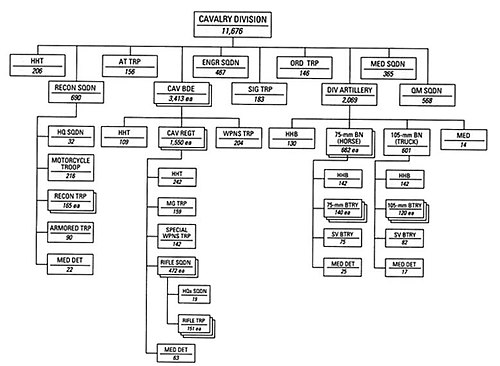Interwar period
The 2nd Cavalry Division was constituted in the Regular Army on 20 August 1921, allotted to the Seventh Corps Area, and assigned to the Second Army. Although the division headquarters was not activated until 1 April 1941, many of the units of the division were active from 1921 to 1940, and many others were active as "Regular Army Inactive" (RAI) units by being manned with personnel of the Organized Reserve. The active elements of the division in the 1920s and 1930s consisted mainly of the cavalry regiments, Troop A, 9th Engineer Squadron, the various artillery units assigned during the period, and elements of the quartermaster train (later the 17th Quartermaster Squadron). The division’s designated mobilization station was Fort Riley, Kansas, where many of the units were concentrated in the 1920s and 1930s, and where they conducted their annual summer training. On 15 August 1927, under special instructions from the War Department, the division was reorganized to consist of the 2nd, 4th, 12th, and 14th Cavalry Regiments, the 4th Field Artillery Battalion, and the 16th Observation Squadron. Other active elements assigned were the 14th Ordnance Company and the 5th, 6th, and 7th Pack Trains. The division Headquarters and Headquarters Troop (HHT), 3rd and 4th Cavalry Brigade HHTs, 2nd Signal Troop, and 8th Pack Train were to be formed from unit and post support personnel at Fort Riley, while the quartermaster train headquarters, 27th and 28th Wagon Companies, and the 2nd Medical Squadron were to be formed from post support personnel at Fort Leavenworth. The rest of the units were to be activated from existing units at Fort Riley and RAI units in the Organized Reserve.
After RAI units were authorized to be manned by Reserve personnel in 1926, units of the 2nd Cavalry Division began to be organized in the Seventh Corps Area, with most being concentrated in the Kansas City metropolitan area. The 3rd and 4th Machine Gun Squadrons (which were to be formed from cadre from the 2nd Machine Gun Troop at Fort Riley), division special troops, and later, the inactive elements of the 2nd Armored Car Squadron were all organized with reservists in Kansas City. These units conducted their summer training at Fort Riley, and therefore had a relatively close association with the division units located there. Thus, in the event of mobilization, the 2nd Cavalry Division was most likely to be the first inactive division to be able to completely mobilize. Like many of the inactive Regular Army divisions, the 2nd Cavalry Division headquarters was organized provisionally from time to time for command post exercises, particularly those involving the exercises of the I Cavalry Corps.
As part of the general buildup of the US Army prior to World War II, the War Department directed the activation of the division at Fort Riley in the fall of 1940, where the majority of the division’s active units were already concentrated. The first major element activated was the 3rd Cavalry Brigade on 15 October 1940, followed by the 4th Cavalry Brigade (Colored) on 21 February 1941, and the division headquarters on 1 April 1941. The 4th Cavalry Brigade's regiments, the only two available for assignment, were segregated units; the division, therefore, was unique to Army structure at that time, a racially mixed unit.
Neither Fort Riley or the adjacent Camp Funston had adequate facilities for the division's mounted units, personnel shortages continued, and divisional elements were activated using provisional assets. General John Millikin, the 2nd Cavalry Division commander in June 1941, envisioned a combined use of mechanized and horse cavalry within the division. During July, Troop A, 2nd Reconnaissance Squadron, was formed provisionally as a mechanized divisional element. The division, now organized with horses, scout cars, jeeps and motorcycles, spent most of the rest of the summer training with its new equipment.
The 2nd Cavalry Division participated in the Second Army Maneuvers of late August as a component of the "Red" forces facing the VII Corps' "Blue" army. Given the task of capturing Arkansas and Louisiana, the 2nd's mission ended on 9 September with divisional elements located at Chatham, Louisiana. During the next week, the division became part of a second training operation. This time, the division served with the Second Army's "Red" force, now challenging the Third Army's "Blue" force. Second Army's first goal was to defeat and remove the Blue forces from southern Louisiana, and then to keep the enemy from capturing Shreveport. At the close of these maneuvers, the 2nd Cavalry Division returned to Kansas, having prevailed with Blue forces still forty miles from the city.
By 2 November, the division possessed a number of its organic support troops, although most were still functioning in a provisional status. The end of the month found the division involved in another set of training maneuvers. The operation, called "PRACTICE BLITZKRIEG," was based in Kansas, and finished with the 2nd Cavalry Division's capture of Topeka. The exercise ended when the divisional military police unit "seized" the governor, who feigned a surrender of the state. [2]

